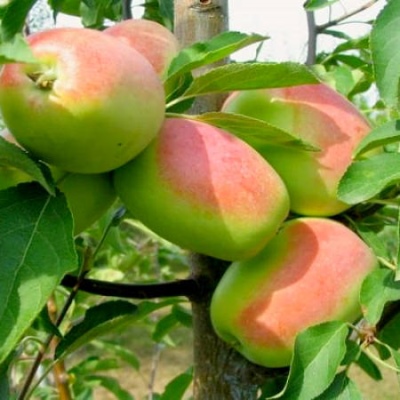
- Authors: Russian folk selection
- Taste: sweet, with a slight, subtle sourness
- Scent: pleasant dessert
- Fruit weight, g: 180
- Fruit size: large
- Yield: 170 kg
- Frequency of fruiting: in a year
- The beginning of fruiting varieties: for 4-5 years
- Ripening terms: autumn
- Removable maturity: in the first half of September
In the garden, I would like to plant such apple trees so that you can enjoy ripe fruits at the end of summer, and in autumn, and in winter. One of these is the popular folk variety Rosemary, which quickly takes root in different climatic conditions.
Breeding history of the variety
There are several versions of the appearance of this variety, but most biologists are inclined to believe that Rosemary turned out with one of Antonovka's selections. This is due to the fact that Rosemary and Antonovka are very similar in appearance. This apple species was bred in 1990.
Description of the variety
Rosemary is a late autumn dessert apple variety. The tree with powerful spreading branches is rather large, with a rounded or pyramidal crown. During the flowering period, the crown of the tree is very dense, covered with small flowers, which outwardly resembles an air cloud.
Features, pros and cons
This variety has a number of features that make it very popular with gardeners and farmers who grow apple trees for commercial purposes. The peculiarities of the species include high yield rates, quick adaptation to different soils, winter hardiness, good keeping quality (up to 3-4 months), as well as excellent taste of fruits. Along with the advantages, the Rosemary variety has some disadvantages - late fruiting and special storage conditions (the place must be cool).
Ripening and fruiting
The flowering period begins in late spring and lasts up to several weeks, and the first fruits can be tasted in September. Stable fruiting lasts about 10 years after planting the seedlings, and then gradually decreases. The tree bears fruit according to a certain schedule - in a year. The timing of active flowering and fruiting can be shifted due to climatic features. Fruiting is often delayed until mid-October.
Growing regions
Since Rosemary is resistant to temperature fluctuations, it is grown in different regions of the country - from north to south. In addition, the variety has taken root well in Belarus and Ukraine.
Yield
The yield indicators are very high. On average, during the fruiting season, each adult and healthy tree is capable of producing up to 170 kg of fruit. In addition, the apples do not fall off, so the percentage of carrion is minimal.
Fruits and their taste
The fruits of the Rosemary apple tree are quite large (the weight of an apple can reach 170-200 grams), with a thin, glossy peel that has a slightly oily structure. The shape of the fruit can be correct - round or round-conical. The taste of apples is memorable, because it has a pronounced sweetness, aroma, juiciness, barely perceptible sourness, which gives piquancy to the fruit. The color of the apple is bright green, which smoothly turns into a red blush. It is believed that this apple type is one of the most delicious, juicy and aromatic.

Growing features
You can grow seedlings in almost any region. Before planting, you need to select a site and clear it of weeds, dig it up so that the soil becomes airy, able to breathe, saturate with fertilizers, prepare special holes, and then just plant. Optimally correct for the rosemary apple tree will be a fertile soil, protected from drafts and strong winds, well lit by the sun's rays, and also far from groundwater.
Saplings are planted in autumn and spring. In the southern regions, seedlings are planted in the spring, when the soil is warm enough, and in the north, planting is carried out in the fall, a month before the first frost.



Pollination
The tree needs cross-pollination, so it is necessary to plant pollinating apple trees nearby, which bloom at the same time as Rosemary. The optimal varieties for pollination are the Boyken and Renet champagne apple trees.
Top dressing
Top dressing is essential for the healthy growth and development of the tree. Top dressing is carried out three times a year - liquid fertilizers are applied in spring, mineral types of top dressing are used in summer, and in autumn it will be enough to add compost and wood ash. You need to fertilize from the third year of tree growth.

Frost resistance
The folk variety is frost-resistant. It is able to withstand temperatures down to -30.35 degrees, the main thing is to provide proper care and protect against severe weather disasters.

Diseases and pests
The variety has high immune protection against scab and many pests, but you should not forget about preventive measures. As a preventive measure, it is enough to spray with fungicides.

The apple tree is a popular fruit crop among gardeners.It can be found in many summer cottages. But at the same time, such trees are often affected by various diseases. It is very important to recognize the disease in time and carry out the necessary procedures for a speedy recovery. Otherwise, the fruits will be spoiled, and the tree itself may die altogether.

Review overview
Analyzing the numerous reviews of gardeners and farmers growing apple trees on an industrial scale, it can be argued that the dessert apple variety Rosemary is very tasty, gives excellent yields, perfectly adapts in different soils, easily tolerates transportation, while maintaining its presentation.
In addition, the tree has protection against diseases, and it also does not require special skills during planting and care, which allows even beginners to grow it in their summer cottages.











































































